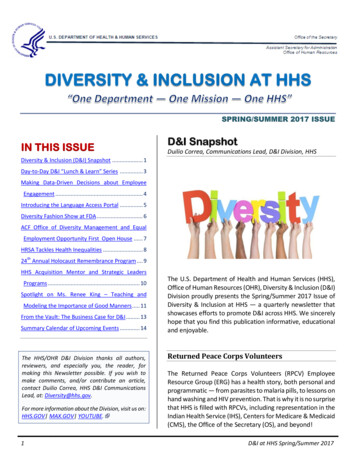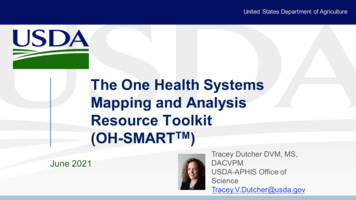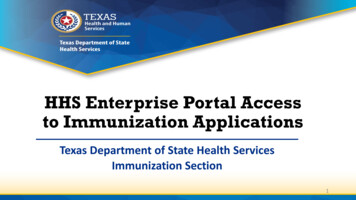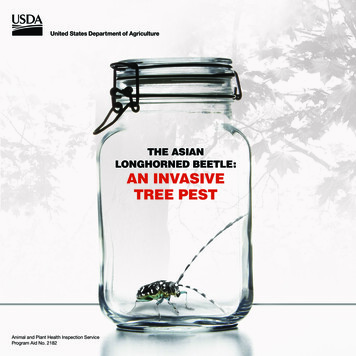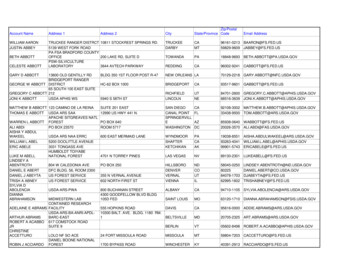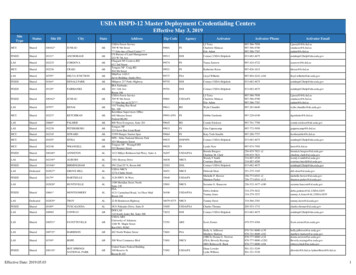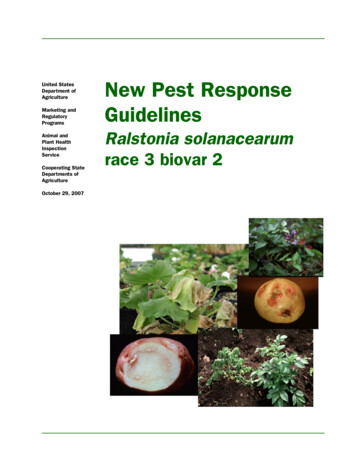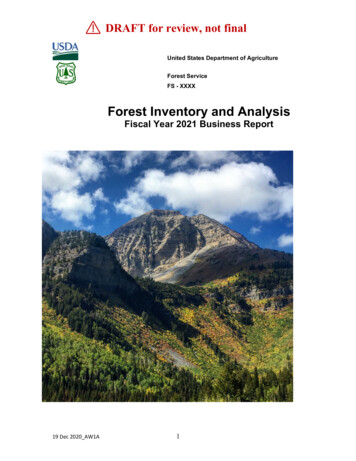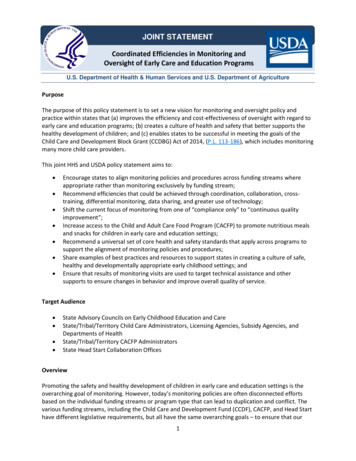
Transcription
JOINT STATEMENTCoordinated Efficiencies in Monitoring andOversight of Early Care and Education ProgramsU.S. Department of Health & Human Services and U.S. Department of AgriculturePurposeThe purpose of this policy statement is to set a new vision for monitoring and oversight policy andpractice within states that (a) improves the efficiency and cost-effectiveness of oversight with regard toearly care and education programs; (b) creates a culture of health and safety that better supports thehealthy development of children; and (c) enables states to be successful in meeting the goals of theChild Care and Development Block Grant (CCDBG) Act of 2014, (P.L. 113-186), which includes monitoringmany more child care providers.This joint HHS and USDA policy statement aims to: Encourage states to align monitoring policies and procedures across funding streams whereappropriate rather than monitoring exclusively by funding stream;Recommend efficiencies that could be achieved through coordination, collaboration, crosstraining, differential monitoring, data sharing, and greater use of technology;Shift the current focus of monitoring from one of “compliance only” to “continuous qualityimprovement”;Increase access to the Child and Adult Care Food Program (CACFP) to promote nutritious mealsand snacks for children in early care and education settings;Recommend a universal set of core health and safety standards that apply across programs tosupport the alignment of monitoring policies and procedures;Share examples of best practices and resources to support states in creating a culture of safe,healthy and developmentally appropriate early childhood settings; andEnsure that results of monitoring visits are used to target technical assistance and othersupports to ensure changes in behavior and improve overall quality of service.Target Audience State Advisory Councils on Early Childhood Education and CareState/Tribal/Territory Child Care Administrators, Licensing Agencies, Subsidy Agencies, andDepartments of HealthState/Tribal/Territory CACFP AdministratorsState Head Start Collaboration OfficesOverviewPromoting the safety and healthy development of children in early care and education settings is theoverarching goal of monitoring. However, today’s monitoring policies are often disconnected effortsbased on the individual funding streams or program type that can lead to duplication and conflict. Thevarious funding streams, including the Child Care and Development Fund (CCDF), CACFP, and Head Starthave different legislative requirements, but all have the same overarching goals – to ensure that our1
nation’s most disadvantaged children have access to what they need to promote their optimaldevelopment.Although the goals of each funding stream may be shared, there is often little sharing of monitoringrequirements, schedules, data and findings across programs. As a result, trends can go undetected andtechnical assistance efforts are not targeted to the areas of greatest need. In addition, while some earlycare and education (ECE) programs receive numerous monitoring visits every year (one or more for eachfunding stream), other programs receive few or none.Monitoring has long been a challenge within states, in part, because of the many factors that affectmonitoring such as funding related to staffing, monitor and provider training and support, enforcement,and provider and parent communication. With the passage of the CCDBG Act of 2014, new basic healthand safety requirements, training requirements and monitoring apply to more ECE programs. Untilreauthorization, states were not required to inspect child care centers annually and family child carehomes were monitored even less frequently. In addition, many states exempted certain categories ofcare from licensing and monitoring requirements despite the fact that they were receiving CCDF andother public support. Under the new CCDBG Act, states are required to conduct annual inspections ofall licensed programs and unlicensed providers (except relatives) that care for children receiving CCDFsubsidy.1The Act also requires an inspection to be conducted before a license is granted, contains new minimumtraining requirements for the inspector workforce, and requires the ratio of licensing inspectors to childcare programs be maintained in a manner that promotes timely and effective inspections.2 If currentmonitoring systems involving the various state and federal programs were better coordinated and,where appropriate, better integrated, more programs could be reached with existing resources and anynew investments could be used more efficiently.This provides states with an unprecedented opportunity to review their overall approach to monitoringand implement a new vision. Through use of technology, data sharing and aligned monitoring, webelieve states can serve more ECE programs and improve the quality of these programs at the sametime. It is the purpose of this policy statement to recommend that states use this opportunity to re-thinktheir monitoring policies and practices to create a more effective monitoring system across programsthat would improve program quality, allow for more efficient use of resources, operate in a moreeffective manner, and better serve children and families.Section I – BackgroundThroughout the United States, more than 266,000 child care programs (centers and homes) arelicensed3 with a capacity for 9.8 million children.4 More than 177,000 programs (centers and homes)participate in CACFP with an average daily attendance of 4.1 million children.5 About 57,685 licenseexempt providers currently serve children whose care is paid for through a CCDF subsidy and will nowbe required to have at least an annual inspection.Funding to states through CCDF and CACFP represent the two largest federal funding streams thatrequire monitoring visits to early care and education settings. Depending on the ECE program andservices provided, other types of monitoring visits may also occur. These include State Quality Ratingand Improvement Systems (QRIS), State-funded preschool, national accreditation, fire safety, sanitation,health, Early Head Start or Head Start, and potentially reviews related to children with special needs.Table 1 shows early care and education programs subject to monitoring throughout the states.2
Although the content and frequency of monitoring visits required by the funding sources may varybased on legislative requirements, they have similar goals and basic programmatic requirements such asstaff qualifications, background clearances, enrollment eligibility, attendance requirements, and certainhealth and safety requirements. It is within these common areas where there may be opportunities forgreater efficiency.Table 1. Child Care and Related Programs Subject to Onsite Monitoring VisitsLicensed Child CareNumber of Licensed Programs Child Capacity6Total Licensed Programs:266,0179,853,135Child Care Centers110,3098,362,036Family Child Care Homes129,8621,151,432Group Child Care Homes25,846339,667Quality Rating and Improvement87,077QRIS systems in 38 statesSystems (QRIS) Participating Programs7NAEYC Accredited Programs87,13650 statesNAFCC Accredited Programs91,40050 statesUnlicensed CareNumber of ProgramsUnlicensed non-relative family child50,330care home providers caring forchildren receiving CCDF subsidies10License-Exempt child care centers7,355caring for children receiving CCDFsubsidies11Non-relative caregivers receiving CCDF 27,739subsidies to care for children in thechild’s home12Child and Adult Care Food ProgramLicensed/ApprovedAverage Daily AttendanceParticipating ProgramsTotal Programs13177,8254,057,714Number of Centers63,9763,280,046Number of Homes113,849777,668Other Related Early Care andEnrollmentLocationEducation ProgramsState funded preschool141,383,45057 programs in 42 statesand DC15Head Start944,5812,932 programsHead Start1,613 programsEarly Head Start (EHS)1,061 programsMigrant and Seasonal Head Start37 programsMigrant and Seasonal EHS15 programsAmerican Indian/Alaska Native (AIAN)148 programsHead StartAIAN Early Head Start58 programsOver the last several decades, effective monitoring policies and practices have been an elusive goal.There are a combination of factors that have challenged states: the largest source of federal child carefunding, the Child Care and Development Block Grant, had no requirement for inspections, states facedwith budget challenges underfunded or cut funds for monitoring, and state policies were not strong as3
agencies sought to draft policy without sufficient resources to undertake monitoring in a more effectivemanner. One trend is clear. Past reports of poor monitoring practices have not necessarily led toimprovements. For example, a 2009 report in Connecticut, “Ensuring Health and Safety in Connecticut’sEarly Care and Education Programs,” an analysis of the Department of Public Health Child CareLicensing Specialists’ reports of unannounced inspections was a comprehensive study reviewing 676child day centers (41% of the state’s supply) and 746 homes (28% of the supply). Among the violationsthat the report identified in child care centers: 48% of the centers had playground hazards,41% administered medicine without a written order,38% had indoor safety hazards,28% had toxic chemicals accessible to children,23% had fire code violations,19% had bathroom sanitation issues,12% didn’t have CPR certified staff, and11% had high chairs without safety straps.Despite the findings of this report and the potential harm for children attending these programs, asimilar report was issued in 2014 by the HHS Office of Inspector General (OIG) that showed many of thesame violations occurring in child care centers and family child care homes in Connecticut.Office of HHS Inspector General Reports on State Monitoring of Child Care ProgramsBetween 2013 and 2016, the OIG issued reports from nine states and Puerto Rico. The OIG found that96% of providers that they inspected had numerous potentially hazardous conditions that failed tocomply with state licensing requirements. The providers served subsidy children and had a history ofcompliance violations (i.e., they were not random). Nevertheless, despite having hazardous conditionsthat could potentially place children at-risk, these programs were (a) licensed and (b) serving CCDFsubsidy children.Weakness in state monitoring and enforcement of licensed child care programs is not new. In 1992, theGovernment Accountability Office (GAO) issued a report, “Child Care: States Face Difficulties EnforcingStandards and Promoting Quality.”16 In 1993 and 1994, HHS’ Inspector General issued reports related toinspections/safety compliance in North Carolina17 and Nevada18 that found many violations similar tothose the OIG has found during the past 3 years. Violations involved: fire code safety, unsanitaryconditions, playground hazards, incomplete employee records, incomplete children’s records, and toxicchemicals accessible to children.19 The Nevada report noted inconsistencies among county monitoringand recommended that “the state provide more specific and definitive guidelines to the jurisdictions toensure uniformity and consistency.” 20A nationwide 1994 OIG report about state child care monitoring across multiple states found similarweaknesses in state monitoring.21 For example, among 169 programs that were reviewed, the OIGfound multiple types of violations including: fire code violations (94), toxic chemicals (84), playgroundhazards (134), unsanitary conditions (394), missing or erroneous employee records, including a lack ofbackground checks (236), missing or erroneous children’s records (191), and other facility hazards(499).22The 2013-2016 series of OIG reports involving licensed child care centers and family child care homes inArizona,23,24 Connecticut,25,26 Florida,27,28 Louisiana,29,30 Maine,31,32 Michigan,33,34 Minnesota,35,36Pennsylvania,37,38 Puerto Rico39 and South Carolina,40,41 shows that there are systemic weaknesses in4
monitoring practices that include the same types of violations first identified 20 years ago. Therefore, itis not just about the number of inspections that are conducted but it is also about the effectiveness ofhow monitoring is conducted – including follow up steps taken after an initial visit where violations arefound.Stakeholder Listening SessionsIn 2016, the U.S. Departments of Health and Human Services and Agriculture held eight joint listeningsessions with key stakeholders to better understand challenges with the current early care andeducation monitoring efforts.42 Included were child care center directors, family child care homeproviders, grantees operating Head Start, Migrant and Tribal grantees, child care resource & referralagencies, state agencies and sponsoring organizations administering CACFP, state licensing officials andrepresentatives from national associations reflecting various ECE sectors. Nearly 100 people providedinput on their experiences with the current monitoring system across the country.In general, some center directors and FCC providers report between 8 to 14 different types ofmonitoring visits to the same site annually while others reported no monitoring visits or infrequentmonitoring with sometimes several years lapsing without a monitoring review.Stakeholder FeedbackThe following is a brief summary (in no particular order) of what we learned during the listeningsessions: Regulations should be more user-friendly, written in plain language, easy to understand, andsupplemented by interpretive guidelines.Inspectors should be supportive, fostering a culture of mutual respect.Monitoring should be more seamless across ECEprograms with a shared core purpose (e.g., providersPerspective from a Provider Operatingrecommended using a common set of health andin Multiple Statessafety requirements across programs to reduceconfusion).“A big problem that we see across statesInspectors should have sufficient training so thatis that licensors have differentinspections are conducted in a moreinterpretations of rules. We understanduniform/consistent manner and by staffhuman factors, but need some type ofknowledgeable about differing requirementsway to promote more uniformity. Somebetween centers and homes.states’ fire department requirements areCommon forms should be developed where possiblein conflict with licensing departments.to avoid conflicting requirements (e.g., conflictingWho do we follow? Last in the door ”requirements between CACFP and child carelicensing or subsidy such as approved attendanceApril 2016 ACF-USDA Listening Sessionsheets or allowable foods. States could review theirnutrition requirements to determine areas of conflictwith CACFP and use CACFP allowable foods as a base to reduce conflicts).Monitoring should be coordinated with duplication reduced (or eliminated).Monitoring checklists should be posted on the internet so that providers understand what isexpected and are not surprised during an onsite visit.Data and documents/previous inspections should be shared among agencies where appropriate.Communication among agencies or among departments within agencies should be improved.5
Monitoring conducted by CACFP and Head Start were viewed as overwhelmingly positive andsupportive, while child care licensing inspections were not. What participants told us made thedifference in CACFP and Head Start monitoring approaches was: Providers felt supported;Although the reviews were for compliance, the monitoring visits did not feel adversarial;They knew the expectations in advance and they understood the requirements; andProviders felt valued and the reviewers offered strategies to promote quality.State licensing administrators discussed challenges that occur when various programs are overseen bydifferent agencies and departments within state government. They described efforts to integratedepartments or divisions to better align monitoring and administration while maintaining the importantpurposes and focus of the underlying programs. Some states have aligned program standards and havecross-walked monitoring needs and strategies. Some states are increasing the use of technology toincrease efficiency, better target technical assistance/support, and identify trends or challenges to beaddressed. Some states have revamped their qualifications in hiring and training inspectors. More detailon state innovative practices is described under the best practices sections of this policy statement.Our stakeholder calls also revealed a frustration beyond challenges related to alignment. For example,licensing agencies are often understaffed which causes a backlog as well as stress among monitors.While licensing administrators agreed that there could be opportunities for greater coordination andefficiency, they also said that they need support from within their administration and state legislature toplace a greater priority on monitoring and oversight.State administrators of the CACFP program stressed the need to improve communication andcoordination among monitoring agencies. In discussion with CACFP agencies,43 three issues arose thatrequire attention and closer coordination between agencies. Responding to Reports of Imminent Danger. While there may be written protocols within stateswith regard to cases where one agency contacts another to report a potential case of imminentharm for a child, CACFP agencies report that follow up by some licensing offices (or otherappropriate agencies) can be delayed by a week or longer. This delayed response placeschildren at risk and suggests that clear protocols are needed – not just on paper, but also inpractice, for all responses to reports of imminent harm. Protection of Children during Investigations. CACFP agencies report that in some cases whenCACFP participation is suspended for imminent threat to children, the children still attend theprogram (although the food program has been suspended). State licensing agencies shouldreview such cases and determine appropriate next steps (e.g., whether parents should benotified, whether the program should be reviewed for appropriate enforcement actions, etc.). Inspection Delays and Backlog. CACFP agencies report delays in fire, safety, and healthinspections that are needed for CACFP at-risk afterschool programs to operate (i.e., public orprivate nonprofit organizations eligible to offer afterschool meals and snacks). Inspectionbacklogs inhibit access to healthy meals and snacks for children. In one state, delays arereported of up to 2 years for a non-school site to obtain the required inspections they need.6
Section II – Federal and State Monitoring ModelsHHS has released several reports recommending efficiencies for monitoring policy and practice acrossearly care and education programs. In 2015, the Office of the Assistant Secretary for Planning andEvaluation (ASPE) in partnership with the Administration for Children and Families (ACF) published,“Innovation in Monitoring in Early Care and Education: Options for States”44 and the Administration forChildren and Families published, “Caring for Our Children Basics: Health and Safety Foundations for EarlyCare and Education.”45 In 2016, the Office of Planning, Research and Evaluation (OPRE) in coordinationwith ACF published, “Coordinated Monitoring Systems for Early Care and Education.”46 These reportsoffer recommendations for more efficient monitoring systems.In addition, the National Center on Early Childhood Quality Assurance (NCECQA) has publishednumerous policy briefs and provides technical assistance on best practices and research to assist statesin developing more effective monitoring systems.47For ECE, there are four primary federal funding streams that have statutory monitoring requirements.These include Head Start, CCDF, the Military Child Care Program, and CACFP. All share one goal – toimprove the quality of ECE programs under their jurisdiction. While CCDF monitoring is described below,for a description of each of the other programs, see Appendix I.Prior to the CCDBG Act of 2014, states were given broader latitude in assuring that health and safetyrequirements and enforcement mechanisms were in place to protect children. Under prior law, 4% offunding was required to be spent on activities related to improving the quality of care but activitiesrelated to quality were not defined. The new law increases accountability for the receipt andexpenditure of child care funding by states and increases the quality set-aside to 12% by FY2020. Itrequires provider background checks and minimum training, new health and safety requirements andannual monitoring of non-relative providers. CCDF is still a flexible funding stream for states; withinfederal regulation, states will need to determine how they can best meet the new minimumrequirements. The challenge for states varies depending upon individual state policies compared to theminimum requirements to protect the health and safety of children under the new law.State Governance Models:As described above, states have considerable flexibility in designing their monitoring systems. And, asdescribed, the new requirements in the CCDBG Act of 2014 have caused many states to re-examine andexpand their monitoring systems.These new requirements have also led several states to rethink their governing structures. Although nota specific purpose of this policy statement, state governance is a major factor in the state’s ability toreduce overlap and align with other statewide efforts such as the Quality Rating and ImprovementSystems. According to a BUILD Initiative policy statement, “A Framework for Choosing a State-Level EarlyChildhood Governance System,” “Governance refers to how (often multiple) entities are managed topromote efficiency, excellence, and equity. It comprises the traditions, institutions and processes thatdetermine how power is exercised, how constituents are given voice, and how decisions are made onissues of mutual concern.”48, 49 Current state ECE governance structures are frequently disconnected.Recognizing this fragmentation, in the 2007 Head Start reauthorization, Congress created the StateAdvisory Councils on Early Childhood Education and Care (SACs) in an effort to prompt states tocoordinate activities and thereby reduce fragmentation, uneven quality, and inequity in programs and7
services.50 In the BUILD Initiative ECE Governance policy statement, three models are described forstates to consider. These include: Coordinated Governance. Coordinated governance places authority and accountability for earlychildhood programs and services across multiple public agencies. In states where this is themodel, the SACs (or their equivalent) seek to improve coordination and collaboration among theagencies. Some have formal agreements or even State legislative guidance to support theirwork. For example, Pennsylvania’s Office of Child Development and Early Learning (OCDEL) is acollaborative venture between the State Department of Education and the Department ofHuman Services.Consolidated Governance. Consolidated governance places authority and accountability for theearly childhood system in one executive branch agency – for example, the state educationagency – for development, implementation, and oversight of multiple early childhood programsand services. One state that has done this is Maryland.Creation of a new Agency. In this model, a state might create a new executive branch agency orentity within an agency that has the authority and accountability for the early childhood system.The governing entity might be an independent state agency with a single mission focused onearly childhood. Georgia, Massachusetts, and Washington have created stand-alone ECEagencies.Examples of Recent State Monitoring Alignment EffortsThe following are examples of states that have made recent changes to improve their State monitoringstructures to better align their efforts:Rhode Island – Aligning among Agencies. In Rhode Island, multiple agencies are responsible foradministering early learning settings: licensing regulations (Department of Children, Youth, andFamilies), QRIS- BrightStars (Department of Human Services), and Comprehensive Early ChildhoodEducation (CECE) standards for preschool (Rhode Island Department of Education or RIDE). The threeagencies worked to compare and align standards to produce a continuum of quality that includes asimilar set of components across all three sets of standards for a better integrated monitoring system.Rhode Island’s work included developing:51 A common application for licensing, BrightStars and CECE approval to reduce the need forprograms to complete three separate applications. Job description and assessor reliability policies for ERS and CLASS assessors to use across bothagencies and to ensure that monitoring is coordinated using the same instruments. An integrated data system that will allow data to be shared across the Departments of HumanServices, Education, and Children, Youth and Families. Training for all front line staff from the three agencies, focusing on topics such as curriculum,health, safety, and family engagement.Georgia – Linking Compliance with Technical Assistance. The Department of Early Care and Learning(DECAL) changed the title of the state’s “licensing monitors” to “child care consultants” to better reflectresponsibilities related to regulation and support in improving Georgia’s child care system. When hired,child care consultants complete standardized on-boarding [orientation] and then mentoring by8
seasoned veteran staff for at least three months. Thereafter, DECAL conducts or contracts for relevant,appropriate professional development to ensure that licensing consultants are adequately equipped tomaintain the balance of monitoring and technical assistance.In 2014, DECAL convened a task force comprised of child care providers and other stakeholders torevamp the agency’s approach to monitoring. The goal of the task force was to recommend anenforcement model that would be: Consistent (easily applied equally to all providers)Transparent (easy to understand)Fair (providers not excessively penalized, especially for violations that they immediately correct),andPredictable (providers know what to expect when rules are violated).The task force recommended a progressive continuum of enforcement designed to better connect orlink regulation and support for providers. The task force’s review resulted in an enforcement chart,52which is based on a point system, and classifies enforcement actions as prevention (P), intermediate (I),or closure (C). Examples of prevention include technical assistance and/or citations. Intermediateenforcement options include fines and restrictions. Closures encompass both license suspension andrevocation. The overall goal is to better support provider needs in attaining and sustaining compliance.Use of the model began July 1, 2016 and is automated within the licensing database; a program’scompliance zone designation and enforcement action, if applicable, automatically computes at eachvisit. A program’s compliance zone (good standing, support, or deficient) is based on a summarymeasure of the program’s 12 month monitoring history with child care licensing rules.53Section III: Moving Toward More Effective Monitoring StrategiesRecommendations & DiscussionThe complex array of early learning programs within today’s environment calls for states to consider anew integrated approach to monitoring. This policy statement offers recommendations to improve theefficiency, cost-effectiveness, and long-term outcomes of monitoring across early learning programs.RECOMMENDATION ONE: Using the Congressionally mandated SACs (or their equivalent), examinethe governance structure of early care and education programs to foster greater coordination,collaboration, and policy alignment. Utilize SACs (or their equivalent) to:oooReview any structural barriers that impede communication, coordination, and alignmentamong the various entities responsible for ECE programs and related funding support.Identify the purpose, function, and expected outcomes of early care and education programs.Determine options that could assist in building a more cohesive early childhood system, whichcould involve consolidating the governance of related early learning programs within oneagency, within a collaborative venture between two agencies, or creating a new agency tohouse early childhood programs.9
DISCUSSION: Many states and localities have worked to better coordinate programs and systeminfrastructure, accelerated by the Race to the Top Early Learning Challenge Fund and federal promotionof coordination in the 2014 CCDBG Act as well as Head Start policies.Yet, in many cases, policies, goals, and oversight strategies are not aligned. Fragmentation in governancestructure and authority can impede the ability to coordinate and share information across programs.There is no single model that is likely to work for every state, however, the Administration for Children &Families (ACF) recommends that every state review any structural barriers that impede communication,coordination, and alignment. How best to structure governance begins with identifying the purpose,function, and expected outcomes of early care and education programs. While it is not easy to re-alignstate governance structures, coordination, collaboration, alignment and accountability may be easier forrelated programs when they are housed under one roof.54 Interviews with agency, department anddivision directors engaged in governance reform recommend that the exact form of governance shouldfollow intended function and that “these functions are present and linked in ways that encourage thesystem’s coordination, coherence, sustainability, efficiency, and accountability at all levels of servicedeli
participate in CACFP with an average daily attendance of 4.1 million children.5 About 57,685 license-exempt providers currently serve children whose care is paid for through a CCDF subsidy and will now be required to have at least an annual inspection. Funding to states through CCDF and CACFP represent the two largest federal funding streams that
